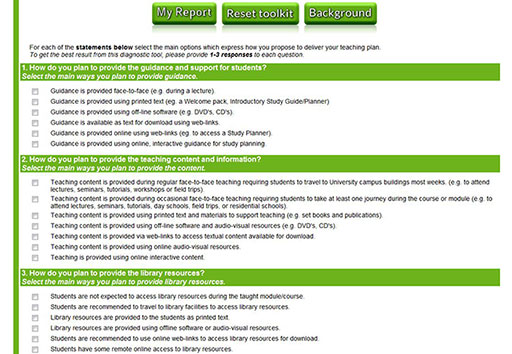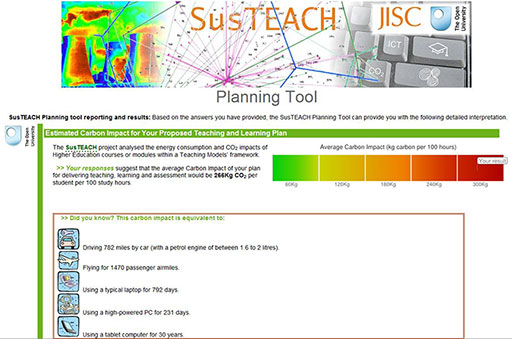4.4.1 Exploring the online SusTEACH Planning Tool
The SusTEACH Planning Tool is a quick tool to use. It provides feedback on your proposed teaching model design, which it compares with the main findings from the SusTEACH project on the carbon impacts of HE teaching.
Explore the SusTEACH Planning Tool
Explore the SusTEACH Planning Tool [Tip: hold Ctrl and click a link to open it in a new tab. (Hide tip)] . [right click and select 'Open In New Window' to view this link]
How do you plan to provide teaching, learning, assessment and communication on a course? Use the Planning Tool to describe your teaching and learning design on a new or existing course, and consider the likely carbon impacts.
Answer
When you have completed your responses and selected ‘My report’, you should receive personalised feedback based on your proposed teaching delivery methods and the likely associated carbon impacts. You can compare your impacts with modes and levels of travel or ICT use that would result in similar impacts as a useful comparison.
This tool also allows you to compare your results with the carbon impacts associated with different teaching delivery models. You can also explore the sustainability in HE teaching models further in the context of carbon reduction targets for the UK.
Compare your result with the examples in Boxes 6 and 7.
Box 6 Using the Planning Tool to estimate the carbon impacts associated with a course in informatics
Let’s take an example of a new postgraduate module in informatics:
- Teaching: The teaching is provided face-to-face and students need to travel to library facilities to access resources. Some of the guidance is provided online and is accessible using weblinks. Some of the teaching content is also provided using online audio-visual resources.
- Learning: Student learning activities are provided as part of face-to-face teaching, e.g. at seminars, tutorials, workshops, field trips, day schools or residential schools. Some learning opportunities are provided using specially developed printed teaching materials and using online links to access website materials.
- Communication: The provision for communication and collaborative learning is mainly face-to-face in the classroom, and is supported using email.
- Assessment: Students are required to submit assignments and projects online and are required to travel to exam theatres for assessment.
The tool summarises the methods used to deliver teaching on this course, which include a high use of face-to-face teaching, a low use of use of printed teaching materials and a low use of ICTs and online methods. This is classified as the ICT-enhanced face-to-face teaching model.
The Planning Tool estimates that the average carbon impacts for this teaching model would be 252 kg CO2 per student per 100 study hours/10 CATS credits. To understand whether this is high or low, the tool produces a number of comparisons.
This impact can be compared with modes and levels of travel or ICT use that would result in similar impacts. This carbon impact is equivalent to:
- driving 740 miles by car (with a petrol engine of between 1.6 to 2 litres)
- flying for 1390 passenger air miles
- using a typical laptop for 749 days
- using a high-powered PC for 218 days
- using a tablet computer for 29 years.
Comparison with other teaching delivery models shows that this carbon impact is comparatively high, although typical for this type of teaching model. This is because face-to-face teaching typically requires a student to travel to attend classes and use university site energy, and can oblige students to take temporary accommodation for the duration of their studies.
Box 7 Using the Planning Tool to estimate the carbon impacts associated with a course in design
Let’s take an example of a new undergraduate module in design:
- Teaching: The teaching is provided mainly online, hosted via the university website (VLE). There are specific computing and hardware requirements for students that include a broadband internet connection and access to other technologies. Students receive a small printed welcome pack and most of the guidance is online and interactive. The teaching content and library resources are also provided online.
- Learning: Student learning activities are provided during online tutorials using Elluminate software. There is a small face-to-face provision for student learning activities during four day schools that students travel to in order to attend. In additio,n there are opportunities for students to record their learning and to collaborate with other students online to support reflection and learning.
- Communication: The provision for communication and collaborative learning is mainly during online tutorials and via internet forums and email.
- Assessment: Students are required to submit assignments and projects online, and to complete some online formative and summative assessments that are assessed as interactive computer-marked examinations.
The tool summarises the methods used to deliver teaching on this course, which include a low use of face-to-face teaching, a low use of use of printed teaching materials and a high use of ICTs and online methods. This is classified as the online teaching model.
The Planning Tool estimates that the average carbon impacts for this teaching model would be 47 kg CO2 per student per 100 study hours/10 CATS credits. To understand whether this is high or low, the tool produces a number of comparisons.
This impact can be compared with modes and levels of travel or ICT use that would result in similar impacts. This carbon impact is equivalent to:
- driving 138 miles by car (with a petrol engine of between 1.6 to 2 litres)
- flying for 259 passenger air miles
- using a typical laptop for 139 days
- using a high-powered PC for 41 days
- using a tablet computer for five years.
Comparison with other teaching delivery models shows that this carbon impact is comparatively low, although typical for this type of teaching model. The online teaching model has lower energy consumption and carbon impacts because students are supported to learn while living at home, which reduces the need to travel to university sites, take additional residential accommodation and utilise campus site facilities. Because students don’t need to be physically on campus, this model can also support increased student numbers without increasing energy consumption on university sites.
You can also explore this tool further by varying your teaching and learning design, and seeing how changing the design affects the likely carbon impacts as estimated from the SusTEACH findings.
What difference would it make if you replaced some face-to-face teaching with an online learning provision? When planning the teaching provision it is important to note the impact of face-to-face teaching provision on the requirement for students to travel and establish residential accommodation during their studies which have significant carbon impacts. A higher face-to-face teaching provision usually creates greater energy demands on university site facilities as well.
Are there any changes you could make to the design of teaching and learning provision to reduce the requirement for students to make journeys, travel long distances and live away from their usual home during their studies?


